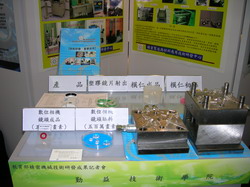Applications of precision machinery upgraded - Conference to announce R&D results of precision machinery technology by technical schools held

On June 7, the MOE and the Taiwan Association of Machinery Industry jointly hosted a conference to announce the R&D results of precision machinery technology, exhibiting 14 items of cooperative R&D results between 11 schools and the industry, which demonstrates the efforts technical and vocational school teachers and students have invested in terms of the R&D of precision machinery. The remarkable R&D results made one feel as if one was looking at the future by standing on a giant's shoulder.
In this Month of Precision Machinery, technical schools displayed developments in the application of precision machinery technology to intelligent mobile phones, molds of optic plastic lenses, precision medical appliances, and aquaculture, hoping to encourage students of relevant departments to build things with their hands as described below:
Category I: Intelligent mobile phones
Sales of mobile phones are growing rapidly and new types of mobile phones are constantly introduced to the market. There are conventional mobiles, intelligent mobiles, and consolidated mobiles (intelligent mobiles with built-in voice communication feature and PDA mobiles). New types of mobiles are constantly being introduced to the market. Chienkuo Technology University's "Precision Product Rapid Development" technology, Far East College's "High Precision Mold Development" technology, "Manufacture of Tungsten Heavy Alloy Fine Blades Using Metal Powder Injection Molding Process" technology of Precision Mold and Die R&D Center, Kaohsiung First University of Science and Technology, and Chaoyang University of Technology's "Virtual Product Development" technology can help manufacturers to rapidly develop mobile casings and conduct minute processing on intelligent chips in order to help domestic mobile manufacturers take the lead internationally.
Category II: Optic lenses for high-pixel digital cameras/mold technology
Demand for molds of high-pixel precision plastic optic lenses is as high as 6,928 units, with 2005 output value reaching NT$4.15bn. In 2006, demand is expected to grow by 32%, with output value being NT$5.5bn. Digital cameras have the biggest demand for molds of plastic lenses, followed by CD-ROM drives. The trend is toward mobiles with built-in cameras. Their potential demand for molds of plastic lenses is emerging with a growth potential that cannot be ignored.
Optic lenses are widely used in optic systems that include the lenses used by video monitoring systems, image scanners, digital cameras, videophones, laser printers, fax machines, CD-ROM drives, and PC video cameras. Therefore, optic lenses are a key component of optoelectronic products and are often nicknamed "the heart of optoelectronics."
The industry can work with academia by acquiring National Chin-Yi Institute of Technology's "Optic Components and Optic Molds" technology, National Yunlin University of Science and Technology's "Hyper Speed Inkjet Processing" technology, Cheng-Shiu University's "Development of High Precision Molds, Non-spherical Micro-lens Array" and "Precision Mechanical/Electrical Systems, Compact Piezoelectric Motor-trolley" technologies, National Formosa University's "Nano Positioning Platform and Optic Measuring" technology, and National Kaohsiung University of Applied Sciences' "Minutely Processed Molds and Products, Remote Virtual Manufacture" technology to facilitate development of optic molds for precision plastic lenses. A brighter future can be created for the optic industry through cooperation between industry and academia.
Category III: Precision medical appliances technology
As technologies used to manufacture medical appliances mature, manufacturers have endeavored to produce better, newer medical appliances and mass produce them. They have continuously developed new kinds of medical appliances that meet the needs of patients and medical care personnel. Developed countries constantly appropriate large sums of funds to raise the health level of their nationals. In the meantime, people are spending increasingly more to obtain physical care. These factors will increase the demand for medical appliances.
Technical school teachers have also invested much effort in this area. Kun Shan University's "Air-conditioning, Filtering Protection Suit," Southern Taiwan University of Technology's R&D of Micro Drug Delivery System and Far East College's "Development and Testing of Medical Appliances" technologies are available for the industry to develop medical appliances.
Category IV: Aquaculture technology
The success in the development of "Portable National Formosa University's "Mobile Aerating Aerobic Detoxifying Machine" raises the growth rate of clams by 80-100% and shortens the breeding time by 3-4 months, raising net income of the clam industry to $2.1bn annually. In addition, it saves 2.4bn tons of water annually and slows down the rate in which the stratum sinks. The technology both raises aquaculture output value and reduces environmental pollution.
The R&D results exhibited at the conference are fairly mature and have reached the level of commercialization. They are highly regarded by manufacturers in industry. In addition to exhibiting R&D results, witnessed by Director of Vocational Education Zhang Guo-bao and Taiwan Association of Machinery Industry Consultant Zhuang Guo-qin, the conference also held the agreement signing ceremony for technology transfer and cooperation between the industry and academia. Meanwhile, cooperation firms from industry, the MOE and school representatives were invited to witness the event.
To allow participants to better understand the current status of technological R&D, in addition to exhibiting physical objects, information including indicators of levels of maturity and commercialization of technologies, tradable technological methods, and applications of technologies and their potential application objects was provided for reference by all circles. Through holding exhibitions of various subjects, the MOE encourages R&D by technical schools, hoping all circles can erect more industry-academia cooperation platforms, accelerating the extension of R&D to industrial markets, and bringing about more industry-academia cooperation with economic value.